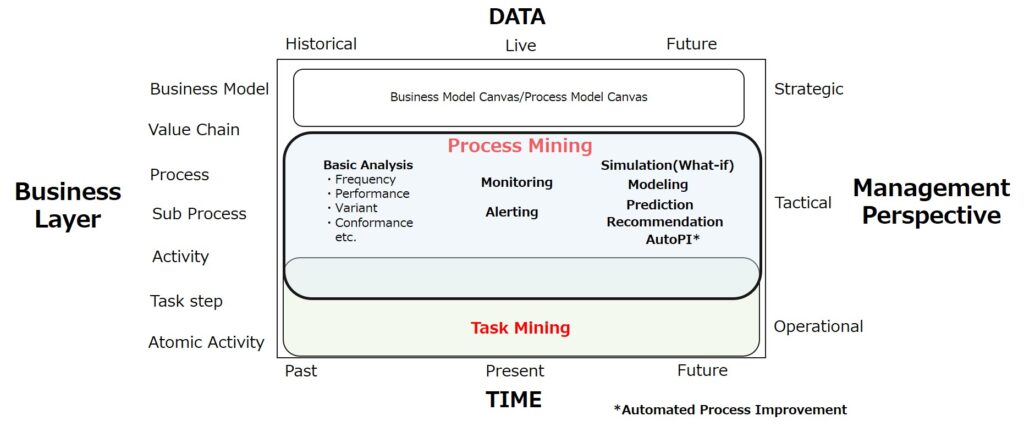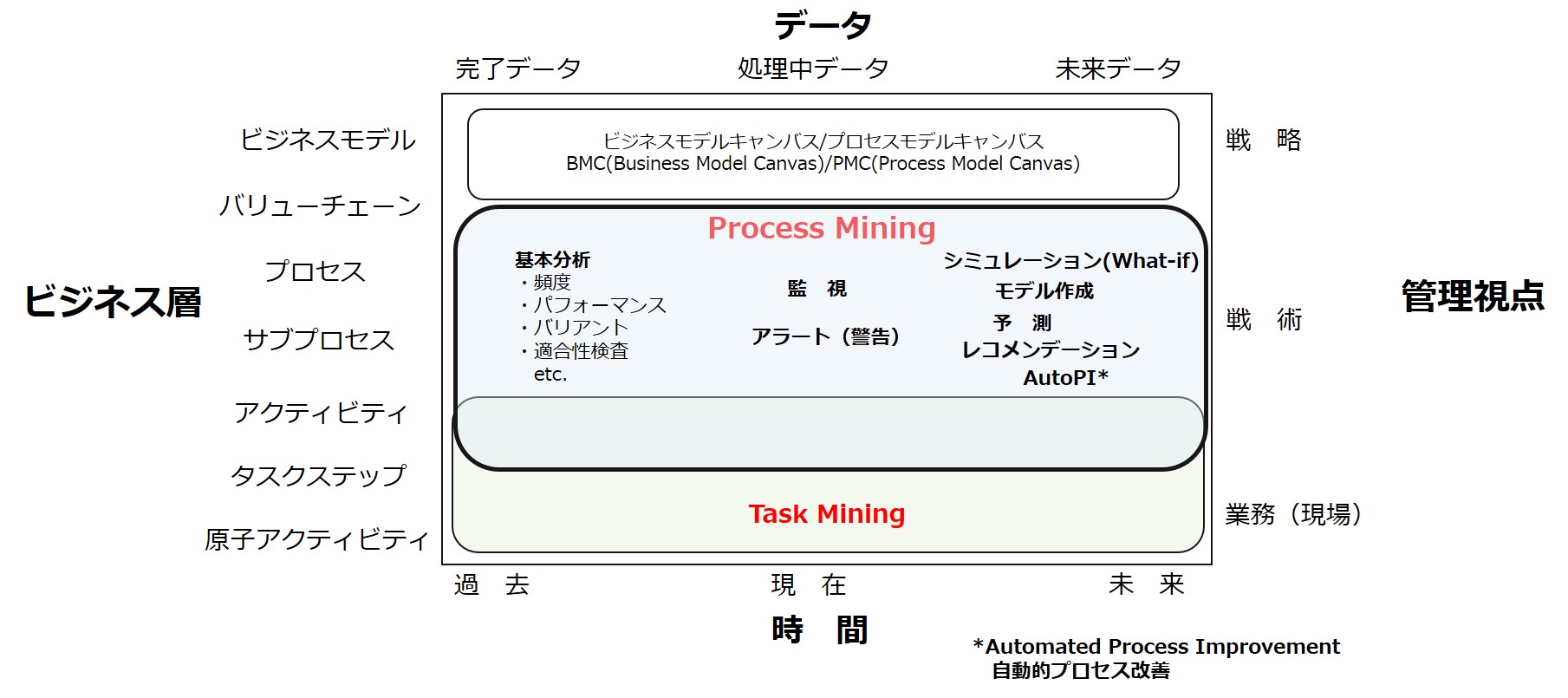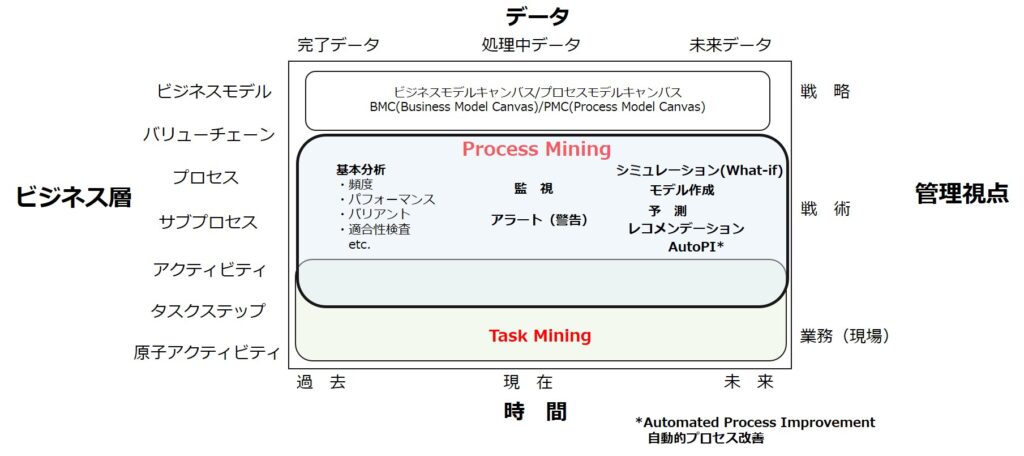Reference Matrix for Process Mining Tool Selection
English follows Japanese. Before proofread.
プロセスマイニングは近年、DX推進・定着に役立つソリューションとしての認知・理解がさらに進みました。また、先のIBMによるmyInvenioの買収や、SAPによるSignavioの買収が示すように、プロセスマイニングが、大手IT企業のソリューションに組み込まれることで、企業のITシステム開発・運営に欠かせない構成要素として重要性が高まっていくことは間違いありません。
さて、企業が、プロセスマイニングを活用したビジネスプロセス改善やシステム改修・開発に取り組むに当たって、言うまでもなく、プロセスマイニングツールの採用が必須であり、自社にとって最適なツールの選定は成功の大きなカギを握っています。
今回は、自社では、プロセスマイニングツールのどのような機能が特に必要となるのかを判断する助けとなるマトリックスを解説いたします。
マトリックスの横軸:時間
分岐対象は、時間と言う視点では、過去の完了したプロセスなのか、それとも現時点で処理中のプロセスなのか、それともこれから遂行されるであろう未来のプロセスなのか、ということです。
一般に、データ分析は完了した過去データを対象に行います。プロセスマイニング分析においても同様で、完了したイベントログデータをプロセスマイニングツールで分析することで、現状プロセスを自動的にモデル化し、様々な視点での分析(基本分析)を行います。
例えば以下のような基本分析があります。
・頻度分析
・パフォーマンス分析(所要時間やコストの視点での分析)
・バリアント分析
・適合性検査(現状プロセスと理想プロセスの比較分析)
など。
プロセスマイニングツールの進化系では、現在進行中のイベントログデータをリアルタイムに近い頻度でプロセスマイニングツールに取り込んで、リアルタイム監視を行い、逸脱などの問題を探知すれば、関係者にアラートを出すという機能を備えています。
これから行われるであろう未来のプロセスについては、以下のような機能が対応します。
・シミュレーション(What-IF)
現状のプロセスをなんらか改善した場合に、どれだけの改善効果(スループット短縮やコスト削減など)が得られるのか、シミュレーションを実行する。
・モデリング
実装すべき理想プロセスの流れをBPMN形式でモデル化する。
・予 測
仕掛中案件が、今後どのような手順で処理されていくことになるのか、所要時間がどの程度になるのか、といった予測をAIなどを活用して行う。
・レコメンデーション
上記予測結果を踏まえて、問題発生や処理時間の長期化を未然に防ぐための最善の打ち手を提案する。
・自動的なプロセス改善(AutoPI:Automated Process Improvement)
プロセス改善のための打ち手を一定の条件において、プロセスマイニングツールが自動的に実行し、迅速な対応を実現する。
マトリックスの縦軸:ビジネス層
ビジネス層とは、プロセスの視点でより詳細な構成要素に因数分解していくものです。管理的には、上位にあるほど「戦略的」であり、下層にむかって「戦術的」、そして「業務的(日々の現場管理)」な視点が必要となります。
最上部は、ビジネスモデルです。そこから、企業全体のプロセスをEnd-to-Endで把握するバリューチェーン、バリューチェーンを構成する個々のプロセスと粒度が細かくなっていきます。
どのようなビジネスプロセスであれ、それはいくつかのサブプロセスに分解できます。さらにひとつのサブプロセスは、より細かいタスクで構成され、そのタスクは複数のアクティビティで構成されています。
たとえば、経理部門での「請求書処理」というサブプロセスを考えると、これは「請求書を受領する」、「請求書の内容を確認する」、「請求書を経理システムに登録する」、登録した請求書に対する支払処理を行う」といったアクティビティが含まれます。
これらのアクティビティのうち、「請求書を受領する」の場合、「PDF請求書添付のメールを開封する」、「添付されたPDF請求書をダウンロードする」といった一つひとつのタスクステップが実行されていくことになります。
さらにこうしたタスクステップは、PCの操作単位では、メールソフトアイコンをクリック、メール開封をクリック、添付ファイルをクリックといった最小単位のアクティビティが実行されており、これらはこれ以上分解できないアクティビティであることから「原子アクティビティ」と呼ばれます。
プロセスマイニングが分析対象とするのは、基本的には、プロセス層からアクティビティ層(場合によってはタスクステップ層)です。ITシステム内に記録されているトランザクションデータは多くの場合、比較的粒度の粗いアクティビティレベルであるという分析対象データそのものの制約があります。
そこで、より粒度の細かいタスクステップ、原子アクティビティまでの分析を行うために活用されるのがタスクマイニングです。タスクマイニングはまだ誕生したばかりの分析手法であり、BI的な集計以上の深い分析方法についてはまだ試行錯誤の段階ではありますが、プロセスマイニングと併せて活用することで、特にRPAによるプロセス自動化に貢献します。
さて、貴社のビジネスプロセス課題と照らして、分析対象とすべきなのは、過去、現在、未来のどれでしょうか?また、ビジネス層としては、どの粒度のプロセスでしょうか?
ツールベンダーのご担当の方とは、一緒にこのマトリックスを見ながら、自社はどこに問題意識を持っているのかを認識しつつ、これらの機能をどの程度実装できているかを把握していきましょう。
なお、マトリックスには記載しておりますが、プロセスマイニングの対象とはならない、ビジネスモデル層については、ビジネスモデルキャンバス(BMG:Business Model Canvas)、プロセスモデルキャンバス(PMG:Process Model Canvas)といったツールが活用できます。
Reference Matrix for Process Mining Tool Selection
In recent years, process mining has been further recognized and understood as a useful solution for promoting and establishing DX. In addition, as shown by the recent acquisition of myInvenio by IBM and Signavio by SAP, there is no doubt that process mining will become increasingly important as an indispensable component of corporate IT system development and operation as it is incorporated into the solutions of major IT companies.
Needless to say, the adoption of process mining tools is essential for companies to improve their business processes and to renovate and develop their systems using process mining, and the selection of the best suited tool for your company is a major key to success.
In this article, I will explain a matrix that will help you determine what functions of process mining tools are particularly necessary for your company.
●Horizontal axis of the matrix: Time
From the perspective of time, there are three dimensions which are completed processes in the past, processes in progress at the moment, and future processes to be executed in the future.
In general, data analysis is done on completed historical data. The same is true for process mining analysis. By analyzing completed event log data with process mining tools, we can automatically model current processes and analyze them from various perspectives (basic analysis).
For example, the following basic analysis is available.
- Frequency analysis
- Performance analysis (analysis from the perspective of time required and cost)
- Variant analysis
- Conformance checking (comparative analysis of current process and ideal process)
etc.
There are some process mining tools which can do continuous monitoring and if problems such as deviations are detected, alerts are sent to the relevant parties by importing ongoing event log data to the process mining tool at a frequency close to real time.
For future processes that will take place in the future, the following functions will be supported.
Simulation (What-IF Analysis)
Simulate how much improvement (throughput reduction and cost reduction, etc.) can be obtained if the current process is improved in some way.
Modeling
Model the flow of the ideal process to be implemented in BPMN format.
Forecasting
predict how in-process projects will be processed in the future and how much time will be required by using AI.
Recommendations
Based on the results of the above predictions, the tool proposes the best measures to prevent problems from occurring and prolonging the processing time.
Automated Process Improvement (AutoPI)
A process mining tool automatically executes measures for process improvement under certain conditions to achieve a quick remedy.
●Vertical axis of the matrix: Business layer
The business layer is a factorization into more detailed components from a process perspective. Administratively, the higher the layer, the more “strategic” it is, and the lower the layer, the more “tactical” it is, and the more “operational” (day-to-day on-site management) it needs to be.
At the top is the business model. From there, the granularity becomes finer, including the value chain that grasps the processes of the entire company from end-to-end, and the individual processes that make up the value chain.
Any business process can be broken down into a number of sub-processes. One more sub-process is composed of finer-grained tasks, and those tasks are composed of multiple activities.
For example, if we consider a sub-process called “invoice processing” in the accounting department, this includes activities such as “receiving invoices,” “checking the contents of invoices,” “registering invoices in the accounting system,” and “processing payments for registered invoices.
Among these activities, in the case of “receive invoice,” each task step is executed one by one, such as “open the email with the PDF invoice attached” and “download the attached PDF invoice.
In addition, these task steps are executed in the smallest units of PC operations, such as clicking on the mail software icon, clicking on open mail, and clicking on the attachment. These are called “atomic activities” because they cannot be decomposed any further.
Process mining basically analyzes the activity layer (or task step layer, as the case may be) from the process layer. transactional data recorded in IT systems are often at the activity level, which is relatively coarse-grained. In many cases, transaction data recorded in IT systems is at a relatively coarse activity level.
Therefore, task mining is used to analyze task steps and atomic activities with finer granularity. Task mining is still in its infancy, and it is still at the stage of trial and error for deeper analysis besides BI-like aggregation. However, by using it together with process mining, it can contribute to process automation, especially with RPA.
Now, in light of your company’s business process issues, which should be the target of analysis: past, present, or future? Also, at what granularity should the process be analyzed as a business layer?
With the person in charge of the tool vendor, let’s look at this matrix together to understand the extent to which these functions can be implemented while recognizing where the company is aware of the issues.
For the business model layer, which is not subject to process mining, tools such as Business Model Canvas (BMG) and Process Model Canvas (PMG) can be used.



